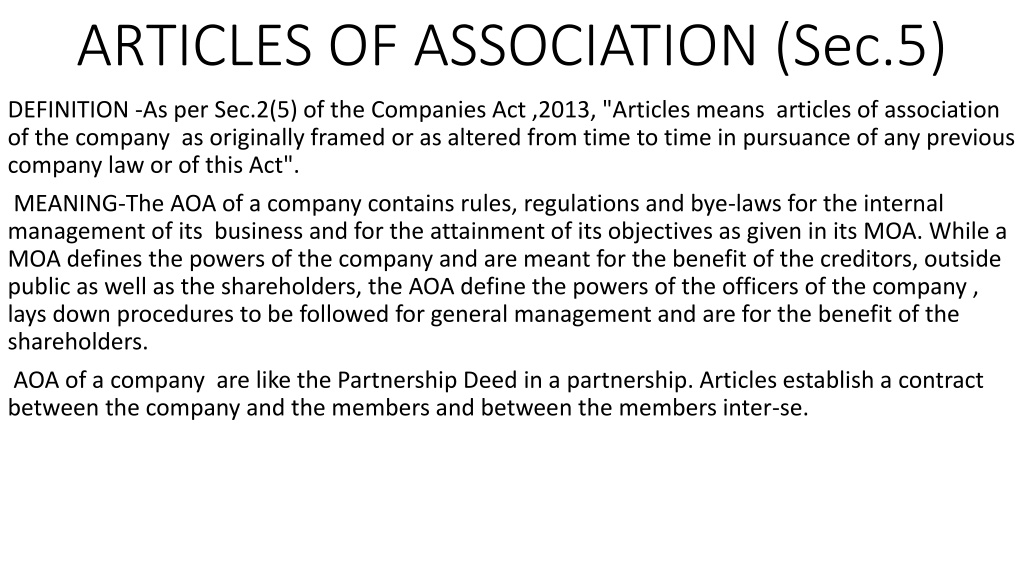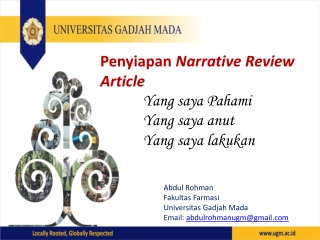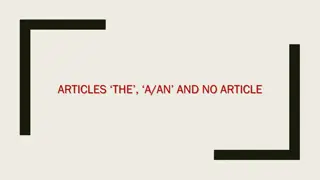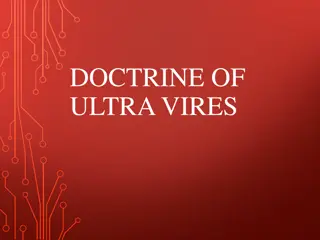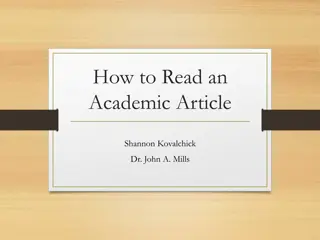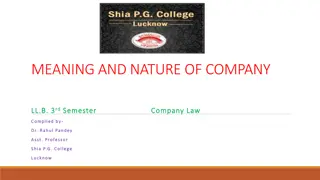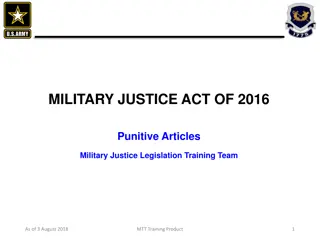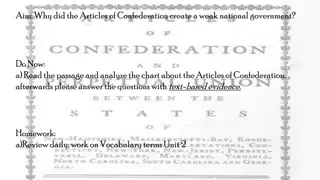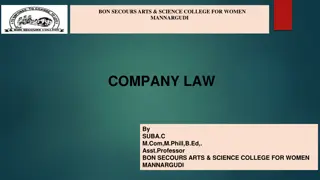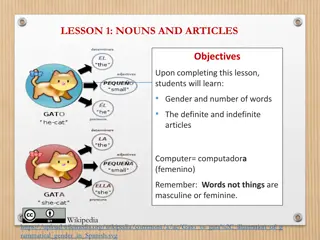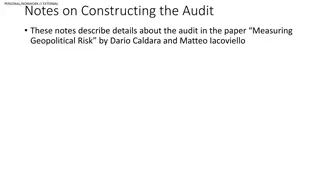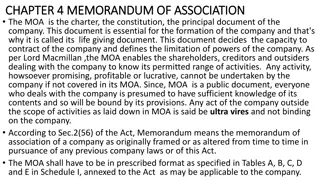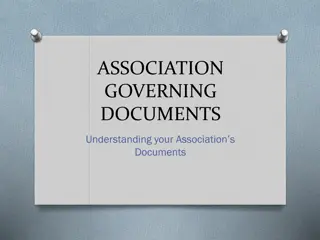Understanding Articles of Association in Company Law
Articles of Association (AOA) play a crucial role in a company's internal management, outlining rules and procedures for various aspects like share classes, appointments, meetings, borrowing powers, and more. They complement the Memorandum of Association (MOA) by focusing on internal workings and shareholder benefits. AOA can be freely altered by companies, subject to certain statutory requirements and limitations. They establish a contractual framework among members and set the stage for effective governance.
Download Presentation

Please find below an Image/Link to download the presentation.
The content on the website is provided AS IS for your information and personal use only. It may not be sold, licensed, or shared on other websites without obtaining consent from the author. Download presentation by click this link. If you encounter any issues during the download, it is possible that the publisher has removed the file from their server.
E N D
Presentation Transcript
ARTICLES OF ASSOCIATION (Sec.5) DEFINITION -As per Sec.2(5) of the Companies Act ,2013, "Articles means articles of association of the company as originally framed or as altered from time to time in pursuance of any previous company law or of this Act". MEANING-The AOA of a company contains rules, regulations and bye-laws for the internal management of its business and for the attainment of its objectives as given in its MOA. While a MOA defines the powers of the company and are meant for the benefit of the creditors, outside public as well as the shareholders, the AOA define the powers of the officers of the company , lays down procedures to be followed for general management and are for the benefit of the shareholders. AOA of a company are like the Partnership Deed in a partnership. Articles establish a contract between the company and the members and between the members inter-se.
ARTICLES OF ASSOCIATION FORMAT of AOA -The AOA of different companies shall be in respective format as specified in Tables F, G, H, I and J given in Schedule I , appended to the Act. The company may adopt all any of the regulations contained in the model articles applicable to such a company. Table F - Model AOA of a Company Limited by shares Table G- Model AOA of a Company Limited by Guarantee & having share capital Table H- Model AOA of a Company Limited by Guarantee & not having share capital Table I- Model AOA of Unlimited Company& having share capital Table J- Model AOA of Unlimited Company and not having share capital
ARTICLES OF ASSOCIATION CONTENTS of AOA- Articles usually deal in matters such as Different classes of shares and their rights Procedure of issue, transfer, transmission, forfeiture, reissue etc of shares Appointments, powers, duties, qualifications etc. of auditors, directors, managers, secretary, MD etc. General Meetings, proxies, polls, Board Meetings and proceedings thereof Voting rights of members Borrowing powers of directors Issue, allotment, alteration, reorganisation, consolidation etc.of share capital Keeping of books of account and their audit Arbitration provisions etc. In case of private companies, the AOA must contain the three restrictions as given in Sec.2(68) namely restriction on right of members to transfer shares;limitation of number of members to 200 and prohibition of invitation to public for subscription of its securities.
ALTERATION OF ARTICLES ALTERATION OF ARTICLES (Sec.14) Articles can be freely altered by the company as often as required. Articles can be altered by passing special resolution i.e. 3\4 majority of members Power to alter articles is a statutory power and cannot be negatived by any way. Articles can be altered with retrospective effect. Copy of special resolution along with copy of altered articles must be filed with Registrar for registration within 15 days of passing the resolution Certain provisions of articles may be entrenched i.e. those provisions can be altered by not just special resolution but by following even stricter or restrictive procedure (say 90% approval or unanimous consent or with approval of minority shareholder etc.) There are certain limitations regarding the alteration of articles
LIMITATIONS REGARDING ALTERATION OF ARTICLES LIMITATIONS REGARDING ALTERATION OF ARTICLES The alteration must not be inconsistent with the provisions of the Companies Act or any other statute. Example - alteration cannot be made to enable a company hold shares of its holding company as, it shall be contrary to Sec.19 of the Act which prohibits subsidiary from holding shares of holding company. The alteration must not be inconsistent with the conditions contained in the memorandum. Articles are subject to Memorandum and must not override the MOA. As such they cannot be altered so as to give powers which are not given by the MOA. The alteration must not be inconsistent with the alteration ordered by the Tribunal. When the Tribunal ,inorder to remedy oppression and mismanagement u\s 241 and 242, has amended the MOA or AOA in any way ,then the company cannot make any alteration which is inconsistent with the Tribunal's order. Approval of Central Government must also be obtained in certain cases. For example if a public company wants to convert into private company, the approval of Central Government is also required. The alteration must not deprive any person of his rights under the contract. A person appointed under an independent contract of service cannot be deprived of any rights possesed under that contract by the alteration of the articles. If an alteration of articles causes breach of contract with the outsider, the company will have to give damages for the .Case- Southern Foundaries Ltd. vs Shirlaw The alteration must not constitute a fraud on minority. If the purpose of alteration is to oppress minority or to give undue advantage to majority holders, then that alteration is void. Case- Menier vs Hooper's Telegraph Works case The alteration must be bonafide for the benefit of company as a whole. Even if it is likely to affect adversely the personal interests of some of the members, the alteration will be valid if it is benefits the company overall. Case- Side bottom vs Kershaw,Leese&Company
ALTERATION OF ARTICLES ALTERATION OF ARTICLES (Sec.14) Important cases Southern Foundaries Ltd. vs Shirlaw The AOA of a company provided that the managing director had to be director and if he ceased to be a director, he could not function as MD .Shirlaw ,a director, entered into an agreement with company by which he was appointed as MD for 10 years. After 3 years this company was taken over by some other company F. After one year, this company F removed Shirlaw from directorship with the consequence that he ceased to be the MD. It was held that this alteration enabled the company to commit a breach of contract with Shirlaw and thus the company is liable to pay damages to S as he was dismissed before his term was over. Menier vs Hooper's Telegraph Works case certain persons were in majority both in Company A as well as Company B. They held a meeting in Company A and passed a resolution to alter the articles and to compromise an action against Company B. The minority holders alleged that the alteration was favourable to Company B but was unfavourable to Company A. Consequently, the resolution was held invalid and set aside. Side bottom vs Kershaw,Leese&Company A private company altered its articles and thereby authorised its directors to order any shareholder, carrying on competitive trade to that of company to transfer his shares at a fair value to persons nominated by the directors. The alteration was held to be valid as it was for the benefit of the company as a whole, even though interests of some of the members were adversely affected.But where an alteration is not in the benefit of the company as a whole but is for the benefit of the majority, then it is not valid.
Binding force of MOA and AOA This implies that once memorandum and articles are registered, they bind the company and the members the same way as if they had been signed by the company and by each member respectively .This means that 1. Company is bound to its members. An individual member can enforce his membership rights such as right to vote, right to recover dividend, right to receive notice etc. against the company if denied by the company. Case- Wood vs. Odessa Waterworks* The directors proposed to pay dividend in kind by issuing debentures. The articles provided for payment of dividends. The court held that payment means payment in cash and therefore the company could be compelled to pay dividend in terms of the articles. 2. Each member is bound to the company.Case-Hickman vs.Kent Sheep Breeders Association* The articles of a company provided for the reference of any dispute between the member and the company to arbitration. Hickman, a member brought an action against the company. The company applied to the court for stay of proceedings (halt on legal proceedings) on the ground that it was bound by the AOA to go for arbitration. The court granted the stay of proceedings. 3, Each member is bound to other members in exceptional case only ( i.e. in case of ultravires contracts/ fraud committed by any shareholder who controls the majority of shares and will therefore not allow an action to be brought in the name of the company). Case-Jehangir R. Modi vs Sham Ji Ladha * In this case the director of the company who was also the member invested the company's funds in some transaction for which he had no authority( ultra vires). So another shareholder filed a case against him( without making the company the party to suit )and the court ordered that the director will have to return back the money to the company 4. Neither the company nor the members are bound to outsiders. Case- Eley vs. Positive Govt. Life Assurance Co.Lmt. The articles provided that Eley shall be company s solicitor for life. After sometime, the company dismissed him. He sued the company for damages for breach of contract. It was held that he had no right of action because the articles did not constitute any contract between the company and outsider.
Doctrine of Constructive Notice This doctrine lays down that after registration, the MOA and AOA become public documents and so it is presumed that everyone dealing with the company has the knowledge of these documents. If the person has not read these documents or understood their implications, he cannot later on plead ignorance or blame the company or hold it liable on ultra vires transactions. If he enters into any transaction which is beyond the powers of the company as set out in those documents, he is deemed to have dealt at his own risk and shall bear the consequences. Eg. If AOA require that a bill of exchange must be signed by two directors , a person having bill signed by only one director cannot claim payment on it.
Doctrine of Indoor management This doctrine lays down that persons dealing with the company are only required to ensure that proposed dealings are apparently regular and consistent with the MOA and AOA of the company. They need not enquire into the regularity of the internal proceedings of the company. They are entitled to presume that the directors are acting lawfully in what they do and can hold the company liable even if the internal formalities have not been complied with.The doctrine of Indoor Management is an exception to the Doctrine of Constructive Notice. While doctrine of constructive notice presumes that outsiders dealing with the company are presumed to have knowledge of MOA and AOA, they are not deemed to have constructive notice of any of its procedural failure . Leading case- Royal British Bank vs Turquand. Here R.B.Bank lent money to a company on the security of a bond signed by two directors given under the seal of the company. The company s AOA permitted borrowing by directors in that way only when authorized by ordinary resolution of a general meeting. The company alleged that no such resolution had been passed by the company and so the loan was taken without its authority. The court held that the company was bound by the contract since the plaintiff was entitled to assume that the necessary resolution must have been made by the company. Exceptions 1. Knowledge of irregularity. Case- Howard vs.Patent Ivory Co 2. Negligence of outsiders.Case-Anand Bihari Lal vs.Dinshaw& Co. 3. Forgery.Case-Ruben vs.Great Fingall Ltd.
Exceptions to Doctrine of Indoor management 1. Knowledge of irregularity. A person having actual / constructive notice of internal irregularity,cannot claim protection under this rule. Case- Howard vs.Patent Ivory Co -The directors of this company ,under the AOA, had authority to borrow more than 1000 only when authorized by a resolution of the company passed in the general meeting. Without any such resolution being passed, they borrowed 3500 from one of the directors by way of debentures. The company later refused to pay the amount. It was held that as he knew about the internal irregularity, his debentures were valid upto 1000 only. Negligence of outsiders. Case-Anand Bihari Lal vs.Dinshaw& Co. Here the plaintiff accepted a transfer of company s property from its accountant. The company did not enforce the contract and when he brought an action against the company , the transfer was held to be void. It was held that since the plaintiff did not even bother to see if the accountant had the power of attorney for executing such a transaction, it shows his negligience and so he cannot be given protection under this rule. Forgery.Case-Ruben vs.Great Fingall Ltd. Here the Secretary of a company forged signatures of two of the directors, required under the articles, on a share certificate and issued it to the plaintiff. The company refused to accept him as a shareholder. When the plaintiff pleaded that whether the signatures were genuine or not was part of internal management and the company should regard him as shareholder, it was held that the certificate was a nullity and he could not take advantage of Doctrine of Indoor Management. This doctrine only applies to irregularities which otherwise might affect a genuine transaction and not to a forgery which is void ab-initio. 2. 3.
Distinction between MOA and AOA MEMORANDUM OF ASSOCIATION ARTICLES OF ASSOCIATION Defined in section 2(56) of the Companies Act and covered in Section 4 of the Act. Defined in section 2(5) of the Companies Act and covered in Section 5 of the Act. MOA contains basic information about the company ,defines its objects and lays down the permitted range of its activities. AOA contain rules for attainment of objects as given in MOA and for management of internal affairs. MOA is the charter/ constitution/principal document of the co. AOA are bylaws/internal regulations for co. s management MOA is subordinate to the Companies Act AOA are subordinate to both Companies Act and MOA . Every company must compulsorily file its MOA with the ROC at the time of incorporation. Public company limited by shares need not file AOA at the time of incorporation if it adopts Table F of Schedule I of Co. Act. MOA defines the relationship of the co. with outside world AOA define the relationship between the co. and its members Table A,B,C,D, and E of Schedule I of Companies Act are model MOA as may be applicable to different types of companies. Table F, G, H, I and J of Schedule I of Companies act are model AOA as may be applicable to different types of companies There is no provision of ENTRENCHMENT CLAUSE in a MOA The AOA of a company may contain ENTRENCHMENT CLAUSE Alteration of MOA is complicated and at times requires not just passing of SR but also approvals from RD/ CG/NCLT/ creditors . AOA can be easily altered by just passing a SR (Special resolution) Acts done by a company ultravires the MOA are void and cannot be ratified by the shareholders. Acts done by the company ultravires the AOA but intravires the MOA are simply irregular and not void and can be ratified subsequently by the shareholders.
